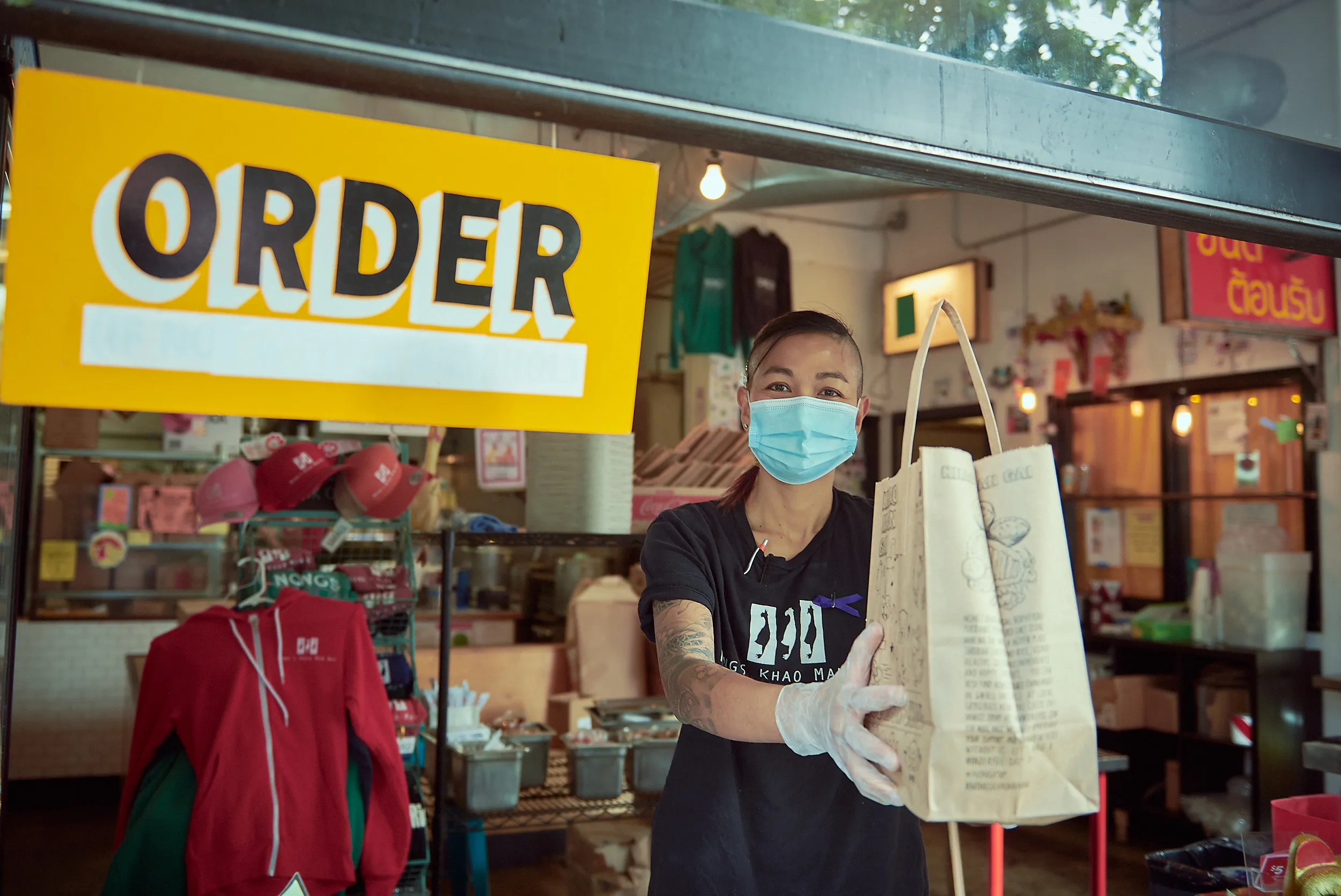Table of contents
In 2009, Nong Poonsukwattana was struggling to make ends meet with her Thai chicken and rice food cart in Portland, Oregon. The carts across the street had long lines, but hers didn’t. Several months into running Nong’s Khao Man Gai, she got a phone call that would change her life forever. It was a reporter from the local newspaper, The Oregonian, who wanted to interview her.
“In my head, I have all the things to worry about for the next day’s operation, like my whole operation—I wasn’t thinking about being in the press,” she recalls.
“When the photographer came by and took pictures, I’ll always remember he said, ‘Do you know this going to be big?’ And I didn’t know quite exactly what he meant.”
Nong Poonsukwattana in the early days of her business.
What he meant was that the day after the story came out, Nong’s Khao Man Gai had throngs of people willing to wait two hours to taste her food, and that continued day after day. She’s since been featured multiple times in The Oregonian, as well as Eater, Vice, PopSugar, and even on Food Network’s “Chopped” in 2014.
“It showed me how powerful the press is,” she says.
Business has been booming. Poonsukwattana now has two brick-and-mortar locations and a very successful sauce line. Her advice to other small business owners?
“Tell your story,” she says. “[Previously], I was working for an American chef doing Thai food. I always wondered, when there are thousands of Thai restaurants, why is his the one getting the attention?” says Poonsukwattana, who immigrated from Thailand in 2003. One reason, she posits, is “because he knows how to explain the food, how to communicate the story, how to talk to the press. All of the dots finally connected for me.”
While Poonsukwattana’s first press experience was serendipitous (the reporter remembered her from the previous restaurant where she worked), there are steps that you can take to get on reporters’ radars, even if you don’t have connections.
The good news is that you don’t necessarily need to invest in a public relations team if you don’t have the resources to do so, nor do you need to make press a big priority. A few updates and assets can set you up to get attention and help you make the most of your time in the spotlight. The best part? It’s a no-brainer to make these changes, because not only will they help journalists find you, but they’ll also help customers find you.
What does media coverage mean?
Media coverage refers to any content created and distributed by a publisher or outlet (other than your own business) in any medium that features you, your business, or your product(s). It can encompass a variety of things: an online publisher including your business or product in a trend roundup or “best of” list; a quote from you on a story related to your industry; a TV spot featuring you cooking a dish from your restaurant; or even a full feature on you sharing your business journey.
How to get media coverage: a checklist
1. Have a website with pertinent contact information
Reporters are often on a tight deadline and will search online for businesses that align with a story they are writing or filming. Make it easy for them to find you and reach out to you. That means making sure you have an online presence.
- Have a website that clearly states the name of your business and what you do
- Include a contact email; not just a contact form. Why? Reporters will likely be reaching out to multiple businesses, and they want to be able to track that they’ve reached out to you. Consider having a dedicated press email address for these types of inquiries so that if an opportunity comes along, you don’t miss it. It also makes your business seem like it gets press inquiries all the time, which only increases your chances of getting opportunities.
- Make your location address prominent (if applicable). List the city where you are based and your business phone on your website where they’re easy to find.
- Include social handles where you are most active so reporters can learn more about you and how you engage your audience. Which leads us to number 2 …
2. Be active on social media
You’ve probably heard this a million times, but here’s one more reason to be active on social: Reporters, producers, casting agents — all of them are scouring social channels to find their next story or star. When covering food trends, for example, reporters will search Instagram or TikTok looking for purveyors who are partaking in that particular trend. Additionally, if you build an engaged following, you become more attractive for media opportunities as publishers and producers see that you have an audience. They can also embed and share videos and photos of your brand in their work without having to formally request assets for their coverage. You don’t have to be on every single channel. Pick one or two that you can consistently keep updated and share the innovative things you’re doing with your business.
Learn more: How to Train Store Associates to Sell on Social Media
3. Make sure your business is optimized for local SEO
If you want to get local press coverage, local press needs to be able to find you. If a reporter is doing a story on wellness trends in Los Angeles, for example, they may start their research by Googling spas in the area. You want to show up in those results. In addition to having your business name, address, and phone number on your site, confirm your business is listed in Google My Business, Yelp, and even the local Yellow Pages, and optimize those listings. Learn more tips for how to level up your SEO game.
4. Have a thoughtful About Us section on your business website
Is your business Black or LGBTQ+ owned in an industry that largely isn’t? Is being eco-friendly a big part of your mission? Are you at the cutting edge of your industry? Do you have a particularly unique or interesting expertise? Do you give back to the community? This is the place to tell your story — a story that a reporter or producer can turn around and pitch to their leadership as a reason why YOU will be interesting to their audience. This story will get your foot in the door and also allow you to control the narrative around your business.
5. Get headshots
Imagine that a reporter reaches out to you, does a fabulous interview, and then asks you for a photo of yourself, and all you have are hastily taken selfies. Some outlets will have a budget to send a photographer to capture original photos, but many do not, and will rely on you. Invest in professional, well-lit, high-resolution headshots that show you in your element and represent your brand so you have them on hand. Get a posed headshot, some action shots, or shots with you and your product, and shots with you and any co-founders, if applicable. Ensure you have both horizontal and vertical options. A good photo can mean the difference between you being the story’s image headliner or you being buried in the middle of the article with no visuals. These photos are also great for you to include on your business website so reporters and customers immediately see your personality and professionalism.
A recent professional shot of Nong Poonsukwattana.
A good example of a press-friendly photo promoting Nong’s Khao Man Gai.
6. Have good product shots
Similar to the point above, good product shots can get you higher billing in an article. For example, if an online publication chooses a product of yours for a piece on “Coziest home decor you have to buy now” and you have a nice image of it, your product may end up being the face of the article — it may even be chosen as the teaser image when the article is shared on social media. Talk about great publicity! Check out Square Photo Studio, which can get you high-quality photos of your products.
7. Put press links on your website
It’s a funny fact of life that after someone sees you getting attention, they want to give you attention as well. Once you start getting press, include links to the stories or videos where you are featured, as well as the logo of the publishers that featured you, particularly if they are reputable organizations. You can either make this a section on your homepage or, once you get enough press, have a press section on your site that houses it all. It’s a badge of honor you should be proud of but, also, other (and sometimes bigger) outlets will see that you’ve had press coverage and may be more apt to reach out.
8. Consider having video on your website
Videos are not only engaging, but they bring you and your products to life. Whether you’re showing your products in action or sharing the story behind your restaurant concept, you’ll be able to show off your personality — which is exactly what producers are looking for. Having video of yourself can capture the attention of people scouting for everything from local and national morning TV shows to digital content for online publications, or even competition shows. You don’t need to invest in some pricey shoot either; a great video can be shot and edited on your phone.
![]()














